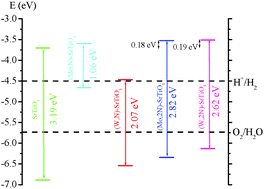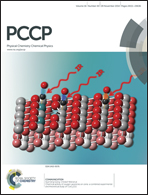A hybrid DFT based investigation of the photocatalytic activity of cation–anion codoped SrTiO3 for water splitting under visible light
Abstract
In this study, the effect of cation (Mo or W) and anion (N) codoping on the band structure of SrTiO3 is investigated to improve its photocatalytic activity for water splitting under sunlight. We consider both the non-compensated and compensated codoping strategies using different ratios of the cationic and anionic dopants. The present study employs hybrid density functional theory to describe the electronic structure of all the systems accurately. Although non-compensated (1 : 1) codoping reduces the band gap significantly, the presence of localized impurity states may hinder charge carrier mobility. This also changes the positions of the band edges to such an extent that the (Mo/W, N)-codoped SrTiO3 system becomes ineffective for overall water splitting. Besides, the formation of charge compensating defects may contribute to the carrier loss. On the other hand, compensated (1 : 2) codoping not only reduces the band gap to shift the absorption curve towards the visible region, but also passivates the impurity states completely, ensuring improved photoconversion efficiency. The reduction of the band gap is found to be more prominent in the case of (W, 2N)-codoped SrTiO3 than (Mo, 2N)-codoped SrTiO3. In both the cases, the band edge positions are found to satisfy the thermodynamic criteria for overall water splitting. Our calculation predicts that the codoping of (Mo/W) and N in the 1 : 2 ratio also enhances the reducing properties at the conduction band in comparison to that in the undoped SrTiO3, which is beneficial for hydrogen release in water splitting. The present study thus demonstrates the effect of the nature of the dopant elements as well as their proportion to achieve the best outcome of the designed material for practical applications.


 Please wait while we load your content...
Please wait while we load your content...